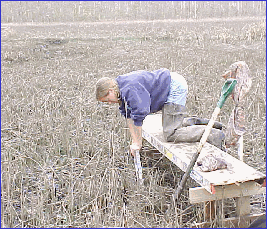 Figure
6. Installation of a peeper in the field.
Figure
6. Installation of a peeper in the field.
Biogeochemistry
Porewaters are sampled in wetland substations to establish the frequency and duration of soil inundation by tidal water carrying ocean derived salts versus soil inundation by fresh water. Increased tidal flooding of wetland areas could result in increased anaerobic conditions in sediments and increased inputs of salt water which may lead to dramatic changes in the basic processes occurring in these sediments. In freshwater anaerobic sediments, organic matter is usually remineralized by methanogens. In the presence of sufficient levels of ocean derived sulfate, methanogenesis is inhibited and sulfate reducing bacteria dominate the remineralization process. The hydrogen sulfides produced are toxic and limit both plant and animal species that are unable to tolerate this bacterial metabolite. Thus, a shift in which pathway dominates remineralization could lead to different communities of plants and animals. Because there are no biotic or abiotic processes for the removal of chloride from wetland sediments, chloride concentrations are an indication of the amount of sulfate supplied to the sediments via seawater. Deviations in the chloride to sulfate ratio from the ratio found in seawater along with low concentrations of methane in porewater samples are used as indicators of a shift in the dominant bacterial processes occurring in the sediments.
 Figure
6. Installation of a peeper in the field.
Figure
6. Installation of a peeper in the field.
Methane concentrations during winter and summer 2000 ranged from less than 10 mM to more than 300 mM and are typical of those encountered in freshwater sediments. Chloride concentrations ranged from 0.5 mM to 129 mM indicating that the stations selected are on the border between fresh and salt water and therefore would most likely experience changes in geochemical cycling due to salinity changes. At stations experiencing higher salinities, the chloride to sulfate ratio found in porewater samples was higher than that predicted by the ratio found in seawater (20:1) indicating that sulfate reduction has occurred at these stations. At lower salinities, the chloride to sulfate ratios were similar to that predicted by seawater indicating that sulfate reduction has not occurred at these stations (Figure 7).